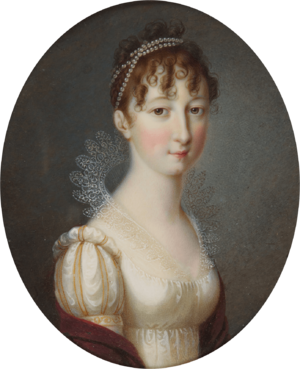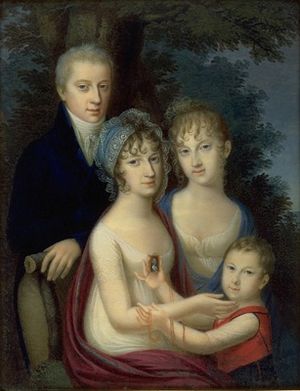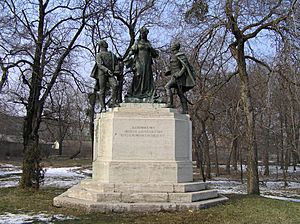Maria Ludovika of Austria-Este facts for kids
Quick facts for kids Maria Ludovika of Austria-Este |
|
|---|---|
| Empress consort of Austria Queen consort of Hungary (more...) |
|
| Tenure | 6 January 1808 – 7 April 1816 |
| Coronation | 7 September 1808, St. Martin's Cathedral |
| Born | 14 December 1787 Monza, Duchy of Milan |
| Died | 7 April 1816 (aged 28) Verona, Lombardy-Venetia |
| Spouse | |
| House | Austria-Este |
| Father | Ferdinand Karl, Archduke of Austria-Este |
| Mother | Maria Beatrice d'Este, Duchess of Massa |
Maria Ludovika Beatrix of Austria-Este (born December 14, 1787 – died April 7, 1816) was an important figure in Austrian history. She was also known as Maria Ludovika of Modena. She became the Empress of Austria when she married Francis I of Austria in 1808. She was his third wife. Maria Ludovika was a member of the House of Austria-Este, a branch of the famous House of Habsburg-Lorraine.
Her Life Story
Growing Up
Maria Ludovika was born in a city called Monza on December 14, 1787. When she was nine years old, her family had to leave their home. This happened because Napoleon's armies took over Northern Italy in 1796. This event made her strongly dislike Napoleon.
Her family moved to Austria. There, the Emperor, Francis I, met her during visits to her mother. He grew fond of her. Maria Ludovika received her education from Countess Almesloë. The Countess was sent by Maria Ludovika’s grandmother, Maria Theresa.
Her Marriage
On January 6, 1808, Maria Ludovika married her first cousin, Francis I of Austria. He was the Emperor of Austria and also the King of Hungary and Bohemia. They did not have any children together. It is important not to confuse her with Marie-Louise of Austria. Marie-Louise was another Austrian princess who later married Napoleon in 1810.
Empress Maria Ludovika was a strong opponent of the French Emperor Napoleon I of France. She led a group in Austria that wanted to go to war against France. This put her against the Austrian foreign minister, Prince Klemens Wenzel von Metternich. France even protested her marriage because of her political views.
Maria Ludovika had a lot of influence over her husband, Emperor Francis I. Many officials were amazed by her skill in ruling. The Prussian minister even called her the "ruling genius" of the court. She was also very popular with the people of Austria. They saw her as a second Maria Theresa, a beloved former empress.
Together with her brother-in-law, Archduke John of Austria, she helped make the idea of war popular. During her coronation in Pressburg, she greatly impressed the Hungarians. They promised a lot of money and military support for the monarchy if it was needed.
However, the Emperor was unsure about going to war. Archduke Charles, Duke of Teschen, who was in charge of military matters, advised caution. Only when the Spanish people revolted in 1808 did the group wanting war finally win.
Metternich tried to discredit her by showing her private letters to her husband. Maria Ludovika held traditional views. She was wary of peasant uprisings. However, she was also very patriotic towards Austria, her adopted country. She was truly upset by the terrible things Napoleon's armies did in Spain. She strongly supported the war against Napoleon's France in 1808.
From this year on, her health began to get worse. She was against the marriage between Napoleon and her step-daughter, Marie Louise, Duchess of Parma, in 1809. In 1812, she was an unwilling guest at a meeting of German rulers. Napoleon had gathered them to celebrate his war against Russia.
Her Final Years
Maria Ludovika was the host of the important Congress of Vienna in 1815. This meeting helped reshape Europe after Napoleon's defeat. After Napoleon was finally defeated, she traveled to her home country, Northern Italy, at the end of 1815. Sadly, she died from tuberculosis in Verona. She was only 28 years old. She is buried in the Imperial Crypt in Vienna.
The Ludovica Military Academy in Budapest was named after Maria Ludovika. It was founded in 1808. She gave 50,000 Forint (an old currency) to help keep it running. This money came from funds announced at her coronation in St. Martin's Cathedral in Pressburg.
The famous writer Johann Wolfgang von Goethe admired Maria Ludovika very much. He felt sad because he had promised not to praise her publicly or say her name in public.
Memorials and Honors
A large marble plaque remembers her visit with the emperor in 1816. It is located at Monza Cathedral.
A large bronze monument was unveiled in 1901 at the Royal Hungarian Ludovica Military Academy. It shows Maria Ludovika in the center. On either side are Archduke Joseph, Palatine of Hungary and János Buttler.
See Also
 In Spanish: María Luisa de Austria-Este para niños
In Spanish: María Luisa de Austria-Este para niños




